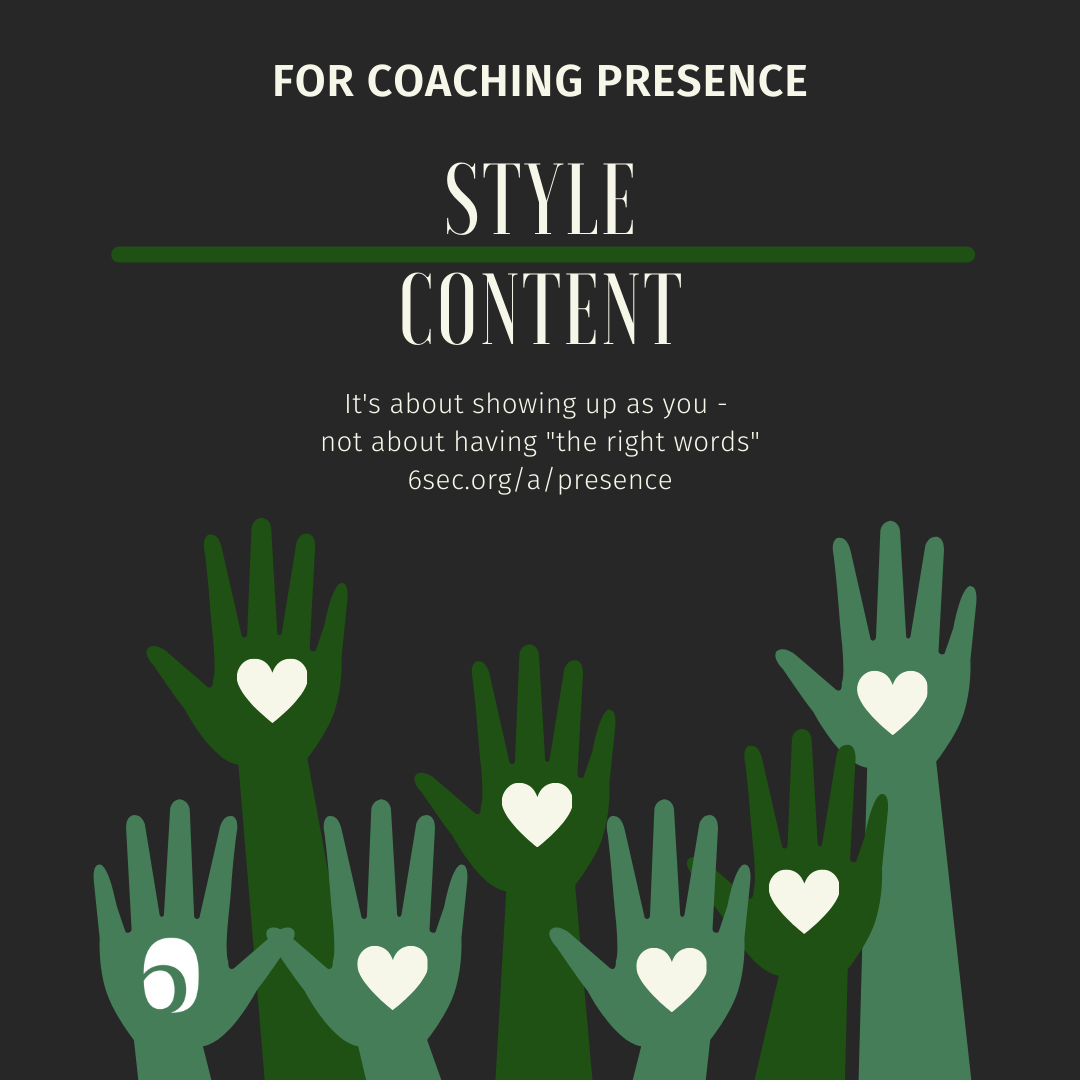Presence is elusive even face-to-face. What happens when you’re flattened into a little box on screen? It takes added “coach power” – new research, plus practical tips below.
Coaching presence, like leadership presence, is easy to feel and hard to put into words. Let’s start with the opposite of presence, ie, absence: When you’re in an online meeting, and someone is checking their email, can you tell? That’s absence. Presence is that in reverse.
It’s becoming increasingly clear that virtual & hybrid interactions are here to stay – as I explain here, these modes of working create added emotional complexity. Given the work-world today, virtual interaction is a growing area of research.
In this new study, Drs. Connelly & Turel found a predictive link between Authenticity → Trust → Teamwork → Performance; in itself important as we look at virtual work and lifting team performance. For the purposes of 1-1 coaching, however, there’s a revelation in the research that’s tangential to the main study:
Participants assessed one another’s authenticity in virtual communication; 48% of the reasons given to assess authenticity were about style of communication, vs 17% to content. The tone, sharing of personal information and emotions, are important factors. These assessments grew over time, and consistency was key.
One of the authors, Ofir Turel, pointed out to me that this doesn’t tell us about the importance of these factors, only the frequency: In this exercise, he said, “people may gravitate toward easy to recall, surface type information, and omit important underlying factors.”
Coaching Presence: Showing Up for Trust
Another of Dr. Turel’s studies looked at authenticity in customer-service text messaging and found that when agents seem more authentic, the information they provide is perceived as having more usefulness. Could this transfer to coaching as we consider how authenticity contributes to the value people place on their learning?
In coaching, the link between authenticity and trust can be described by Coaching Presence. From these studies, we can infer that clients will assess the authenticity of our presence based on factors such as tone, content, consistency, and a match with their expectations. In turn, authenticity is likely to affect trust and the value clients place on what they learn with their coach.
In a virtual context, there are fewer clues. It’s a bit like trying to drink a chunky smoothie through a thin straw. It’s possible to establish an authentic connection, but with that “thin straw” it’s easy to block progress, and it takes extra effort.
Previous research on mirror neurons suggests that when people intentionally focus on emotional clues, they pick up more emotional data. So perhaps when working virtually, we can reverse-engineer that to SHARE emotion clues more clearly.
In a Flat Box Online – Don’t Get Stuck There
From the authenticity research described above, “Authenticity is possibly even more important in online contexts. The paucity of social cues in virtual communication means that each interaction can become disproportionately important” – Connelly & Turel
In online meetings, we’re reduced to two dimensions, each trapped in a small box on a screen. Often the sound quality is mediocre, and coach & coachee are left with little of the rich emotional data we’d find in person. It’s a thin straw.
My own experience, however, is that it’s still possible. We CAN bring our coaching presence forward, it might take extra effort – and since we’re talking about emotional communication, that effort is emotional… more emotional challenge demands more emotional intelligence.
It also demands more energy and focus from us as coaches. In other words, it’s hard work – emotional labor. We can go to the EQ gym and workout to train for this hard work. We also need to set ourselves up by doing things like taking breaks between coaching sessions. I suggest coaching yourself about this with the free online Balance Scale tool that I explained in last-month’s EQ Coaching News.
3 Tips to Strengthen Coaching Presence – Especially Online
I’ve been coaching virtually for over a decade, here are three discoveries I’ve made about my own presence:

Bring the feelings forward
Knowing that our clients will be less able to pick up emotional clues “through the thin straw,” we can help by giving voice to our own feelings. “When I hear you say ___, I feel ___. How about you?” This might surprise you (given my work), but that’s not easy for me. It takes effort to name feelings, but when I do it, it almost always helps.
→ you can take this a step further by using metaphors, tools like the icon finder, or emotion cards (for ideas, check out the “hands on tools” in the EQ Store – try sending a set to your client!)

Inner Stillness & Focus
While we’re trapped in this little box on screen, we’re also magnified. I learned from media training that even a little movement on camera looks big, so I’ve practiced being more still. That stillness starts inside with a feeling of peace, of giving myself to this moment. Then, leaning forward with open body language, looking at the camera*, and giving extra attention to my client.
* this is actually really awkward! It might feel unnatural. Plus, a lot of us are used to looking at clients’ faces on the screen to pick up clues. But for THEM, when you look at the video, it can seem like you’re avoiding contact. You don’t have to obsess, but once in a while, intentionally let your client look you in the eye.

Start with Heart
I love coaching, and I genuinely care about people. I find my clients endlessly fascinating, and I believe in them – I KNOW they have the wisdom within and the resources to create a better future. Sometimes, however, I get caught up in logistics and practicalities – instead, when I start with heart, my feelings focus me and my client. When I let myself feel these feelings of compassion, optimism and confidence, it changes me… I become more relaxed, more open, more hopeful… and that lets me be more fully present, and invites my client to be more fully present as well.
The bottom line is that just like leading-virtually, coaching-virtually requires new skills. Some of those skills are technical, but the most important and challenging parts are emotional. That makes today a perfect time to recommit to practicing emotional intelligence.
See you next month for the next 🌱EQ Coaching newsletter.
If you were lucky enough to have a friend forward this to you… please subscribe here!
Warmly,
– Josh
- Coaching Through the Emotional Recession: Three Practical Tips for Trauma-Informed Coaching - May 1, 2024
- Knowing Isn’t Coaching: Three Emotional Intelligence Tools for Professional Coaches - April 3, 2024
- Coaching Down the Escalator: 3 Emotional Intelligence Tips forCoaches to Reduce Volatility & De-escalate Conflict in a Polarized World - March 6, 2024



These 3 trips are really very true to connect with people, whenever or what, or wherever we are, this shows authentic and at presence to focus on people. I will take these with me! Thanks for share this Josh.
I like this article. I think the tips not apply to the online coaching, but also to other online virtual sessions. For example, I have been doing EQ Cafe online for a few times since the pandemic happened. The stillness before the camera and my personal emotions demonstrated in the session will do a lot of influence to the participants. And I will try to put my feeling of their feelings forward next time. It will be interesting to see their reactions. : )